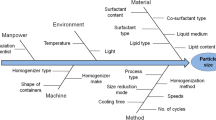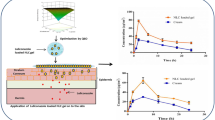Abstract
Purpose
Solid lipid nanoparticles (SLNs) have shown tremendous utility in the topical delivery of such anti-fungal moieties. Hence, it was aimed to develop luliconazole (LCZ)-loaded SLN-based topical nanogel for improvised efficacy against topical fungal infections.
Methods
Response surface methodology–based experimental design, i.e., BBD, was employed to prepare LCZ-SLNs by solvent diffusion method. The SLNs were characterized based on particle size, entrapment efficiency, polydispersity index, zeta potential, and morphological investigations by SEM and transformed into gel form using pH-triggered gelling mechanism. After characterization, pH, viscosity, and texture profile, the developed gel’s ex vivo drug release profiles were investigated, followed by ex vivo permeation studies and dermal retention studies. The developed gel was evaluated in vitro for its antifungal potential against Candida albicans and Sporotheix schenckii, safety, and long-term storage stability.
Results
The results showed the development of spherical shape colloidal nanosize particles (111.33 nm) with no aggregation. The drug entrapment efficiency was 63.65%, and the zeta potential was obtained to be 23.33 ± 2.5 mV, presenting good stability. LCZ showed prolonged in vitro release from SLNs dispersion and gel. In vitro anti-fungal investigation portrayed a significant reduction in the growth inhibition zone (p < .05) compared to the control group. The findings of the study suggest that the developed LCZ-loaded SLN topical gels are safe to use and have long storage stability.
Conclusion
In conclusion, SLNs with optimum particle size, high entrapment efficiency, and modified drug release patterns can offer a promising carrier for the topical delivery of luliconazole-like molecules.






Similar content being viewed by others
Data Availability
Data available on request from the authors.
References
Park N-H, Shin K-H, Kang MK. 34 - Antifungal and antiviral agents. In: Pharmacology and therapeutics for dentistry (Seventh Edition). edn. Edited by Dowd FJ, Johnson BS, Mariotti AJ: Mosby; 2017: 488–503.
El-Housiny S, Shams Eldeen MA, El-Attar YA, Salem HA, Attia D, Bendas ER, El-Nabarawi MA. Fluconazole-loaded solid lipid nanoparticles topical gel for treatment of pityriasis versicolor: formulation and clinical study. Drug Delivery. 2018;25(1):78–90.
Rai VK, Dwivedi H, Yadav NP, Chanotiya CS, Saraf SA. Solubility enhancement of miconazole nitrate: binary and ternary mixture approach. Drug Dev Ind Pharm. 2014;40(8):1021–9.
Anonymous. Luliconazole. In: CSID:8039103. http://www.chemspider.com/Chemical-Structure.8039103.html. Accessed 3 Nov 2023.
Walicka A, Iwanowska-Chomiak B. Drug diffusion transport through human skin. Int J Appl Mech Eng. 2018;23:977–88.
Garg AK, Maddiboyina B, Alqarni MHS, Alam A, Aldawsari HM, Rawat P, Singh S, Kesharwani P. Solubility enhancement, formulation development and antifungal activity of luliconazole niosomal gel-based system. J Biomater Sci Polym Ed. 2021;32(8):1009–23.
Dehari D, Mehata AK, Priya V, Parbat D, Kumar D, Srivastava AK, Singh S, Agrawal AK. Luliconazole nail lacquer for the treatment of onychomycosis: formulation, characterization and in vitro and ex vivo evaluation. AAPS PharmSciTech. 2022;23(6):175.
Panthi VK, Nepal U. Formulation and development of a water-in-oil emulsion-based luliconazole cream: un vitro characterization and analytical method validation by RP-HPLC. Int J A Chem. 2022;2022:7273840.
Alhakamy NA, Al-Rabia MW, Md S, Sirwi A, Khayat SS, AlOtaibi SS, Hakami RA, Al Sadoun H, Eldakhakhny BM, Abdulaal WH, et al. Development and optimization of luliconazole spanlastics to augment the antifungal activity against Candida albicans. Pharmaceutics. 2021;13(7).
Küchler S, Herrmann W, Panek-Minkin G, Blaschke T, Zoschke C, Kramer KD, Bittl R, Schäfer-Korting M. SLN for topical application in skin diseases—characterization of drug–carrier and carrier–target interactions. Int J Pharm. 2010;390(2):225–33.
Moussa Y, Teaima M, Attia D, Elmazar M, El-Nabarawi M. Unroasted green coffee extract-loaded solid lipid nanoparticles for enhancing intestinal permeation. ACS Omega. 2023;8.
Ravi PR, Vats R, Dalal V, Gadekar N. N A: Design, optimization and evaluation of poly-ε-caprolactone (PCL) based polymeric nanoparticles for oral delivery of lopinavir. Drug Dev Ind Pharm. 2015;41(1):131–40.
Chaudhary H, Kohli K, Amin S, Rathee P, Kumar V. Optimization and formulation design of gels of diclofenac and curcumin for transdermal drug delivery by Box-Behnken statistical design. J Pharm Sci. 2011;100(2):580–93.
Rai VK, Yadav NP, Sinha P, Mishra N, Luqman S, Dwivedi H, Kymonil KM, Saraf SA. Development of cellulosic polymer based gel of novel ternary mixture of miconazole nitrate for buccal delivery. Carbohydr Polym. 2014;103:126–33.
Kumar V, Ain S, Kumar B, Ain Q, Gaurav. Optimization and evaluation of topical gel containing solid lipid nanoparticles loaded with luliconazole and its anti-fungal activity. 2020;12.
Kandadi P, Syed MA, Goparaboina S, Veerabrahma K. Albumin coupled lipid nanoemulsions of diclofenac for targeted delivery to inflammation. Nanomedicine. 2012;8(7):1162–71.
Sharma A, Mehta V, Parashar A, Patrwal R, Malairaman U. Solid lipid nanoparticle: fabricated through nanoprecipitation and their physicochemical characterization. Int J Pharm Pharm Sci. 2016;8:144–8.
Rapalli VK, Sharma S, Roy A, Alexander A, Singhvi G. Solid lipid nanocarriers embedded hydrogel for topical delivery of apremilast: in-vitro, ex-vivo, dermatopharmacokinetic and anti-psoriatic evaluation. J Drug Delivery Sci Technol. 2021;63:102442.
Patravale VB, Mirani AG. Preparation and characterization of solid lipid nanoparticles-based gel for topical delivery. In: Pharmaceutical Nanotechnology: Basic Protocols. edn. Edited by Weissig V, Elbayoumi T. New York, NY: Springer New York; 2019: 293–302.
Hussain A, Samad A, Singh SK, Ahsan MN, Haque MW, Faruk A, Ahmed FJ. Nanoemulsion gel-based topical delivery of an antifungal drug: in vitro activity and in vivo evaluation. Drug Delivery. 2015:1–16.
Khandavilli S, Panchagnula R. Nanoemulsions as versatile formulations for paclitaxel delivery: peroral and dermal delivery studies in rats. J Invest Dermatol. 2007;127(1):154–62.
Zhang YT, Shen LN, Zhao JH, Feng NP. Evaluation of psoralen ethosomes for topical delivery in rats by using in vivo microdialysis. Int J Nanomed. 2014;9:669–78.
Maurya A, Murthy SN. Pretreatment with skin permeability enhancers: importance of duration and composition on the delivery of diclofenac sodium. J Pharm Sci. 2014;103(5):1497–503.
Mare AD, Ciurea CN, Man A, Mareș M, Toma F, Berța L, Tanase C. In vitro antifungal activity of silver nanoparticles biosynthesized with beech bark extract. Plants (Basel, Switzerland). 2021;10(10).
Alvarado-Gomez E, Martínez-Castañon G, Sanchez-Sanchez R, Ganem-Rondero A, Yacaman MJ, Martinez-Gutierrez F. Evaluation of anti-biofilm and cytotoxic effect of a gel formulation with Pluronic F-127 and silver nanoparticles as a potential treatment for skin wounds. Mater Sci Eng, C. 2018;92:621–30.
Shrestha S, Pakhrin S, Maharjan S, GC R, Giri S, Thapa N, Jeevan R, Shrestha J. UV spectrophotometric determination of luliconazole semisolid dosage form. 2021.
Rasmussen MK, Pedersen JN, Marie R. Size and surface charge characterization of nanoparticles with a salt gradient. Nat Commun. 2020;11(1):2337.
Arora R, Aggarwal G, Harikumar SL, Kaur K. Nanoemulsion based hydrogel for enhanced transdermal delivery of ketoprofen. Adv Pharm. 2014;2014:468456.
Arora D, Nanda S. Quality by design driven development of resveratrol loaded ethosomal hydrogel for improved dermatological benefits via enhanced skin permeation and retention. Int J Pharm. 2019;567:118448.
Blanco MT, Pérez-Giraldo C, Blanco J, Morán FJ, Hurtado C, Gómez-García AC. In vitro studies of activities of some antifungal agents against Candida albicans ATCC 10231 by the turbidimetric method. Antimicrob Agents Chemother. 1992;36(4):898–901.
Lei J, Xiao W, Zhang J, Liu F, Xin C, Zhou B, Chen W, Song Z. Antifungal activity of vitamin D3 against Candida albicans in vitro and in vivo. Microbiol Res. 2022;265:127200.
Yadav A, Mandal MK, Dubey KK. In vitro cytotoxicity study of cyclophosphamide, etoposide and paclitaxel on monocyte macrophage cell line raw 264.7. Indian J Microbiol. 2020;60(4):511–7.
Lippacher A, Müller RH, Mäder K. Liquid and semisolid SLN™ dispersions for topical application: rheological characterization. Eur J Pharm Biopharm. 2004;58(3):561–7.
Acknowledgements
The authors are thankful to the management of CT University (Ludhiana) for providing research facilities and support.
Author information
Authors and Affiliations
Contributions
All authors have contributed equally to this manuscript.
Corresponding author
Ethics declarations
Ethics Approval and Consent to Participate.
Not applicable.
Consent for Publication
All authors have consent for publication.
Competing Interests
The authors declare no competing interests.
Additional information
Publisher's Note
Springer Nature remains neutral with regard to jurisdictional claims in published maps and institutional affiliations.
Rights and permissions
Springer Nature or its licensor (e.g. a society or other partner) holds exclusive rights to this article under a publishing agreement with the author(s) or other rightsholder(s); author self-archiving of the accepted manuscript version of this article is solely governed by the terms of such publishing agreement and applicable law.
About this article
Cite this article
Khurana, G., Sharma, V.V. & Arora, D. QbD-Driven Development and Characterization of Solid Lipid Nanoparticles (SLNs)–Based Nanogel of Luliconazole for the Effective Management of Dermal Fungal Infection. J Pharm Innov 18, 2249–2264 (2023). https://doi.org/10.1007/s12247-023-09787-6
Accepted:
Published:
Issue Date:
DOI: https://doi.org/10.1007/s12247-023-09787-6




